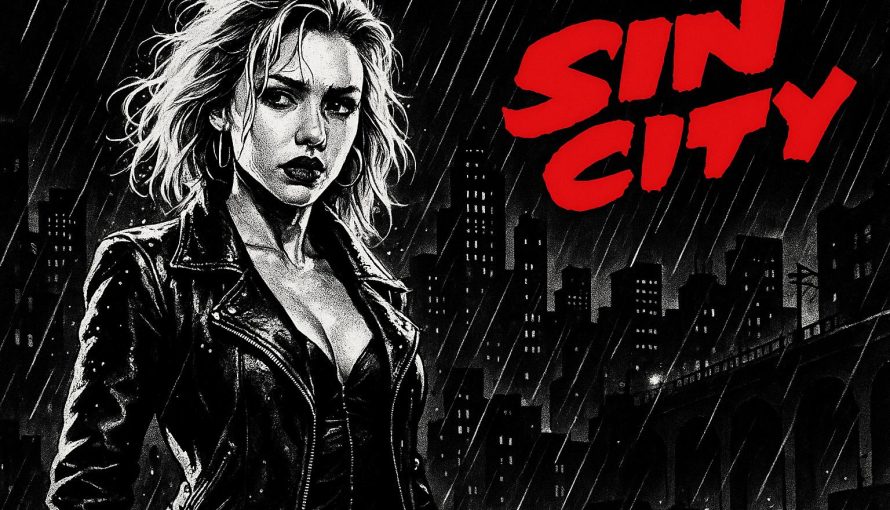Sin City

Overview of Sin City
Sin City is an artful portrayal of a gritty metropolitan area heavily inspired by the gritty aesthetics of film noir. Conceived by the renowned creator Frank Miller, this graphic novel series has become an iconic masterpiece, primarily known for its stark black-and-white artwork, hardboiled dialogue, and deeply intertwined storylines. First published by Dark Horse Comics in the early 1990s, it has significantly influenced the realm of graphic storytelling and impacted many subsequent works in the medium.
Art Style
The artwork in Sin City stands as one of its most defining and captivating features. Frank Miller’s utilization of high contrast black and white imagery serves to create striking visual representations that beautifully emphasize shadows and stark outlines. The distinctive and bold visual approach effectively captures the intensity, mood, and emotional depth of the stories. Alongside this stark imagery, the occasional use of a single color—such as red or yellow—serves as a powerful tool, selectively highlighting certain narrative elements and drawing attention to pivotal details within the storyline. This selective coloring not only enhances specific scenes but also accentuates thematic elements.
The Setting
Set in the fictional realm of Basin City, often referred to simply as Sin City, the series unfolds in a place rife with crime, corruption, and moral ambiguity. The city’s dangerous streets and its corrupt underworld serve as the primary backdrop where residents navigate constant peril and ethical challenges. The setting is not just a passive background; it actively shapes and influences the actions and decisions of its inhabitants. The atmosphere, teeming with danger and uncertainty, becomes almost a character in its own right. A place where survival often depends on one’s wits, strength, and ability to navigate moral shades of gray.
Main Characters
A fascinating array of recurring characters populate the series, each with their own distinct story arcs and challenges. These characters are integral to the fabric of the Sin City narrative, with individual tales that often intersect and influence one another. Among the most notable figures are:
Marv: Marv is portrayed as a hulking man driven by a personal code of justice. His story frequently revolves around themes of vengeance and redemption. His quests often lead him into situations where his moral code is tested against the harsh realities of Basin City.
Dwight McCarthy: Dwight is a complex character entangled in various personal and external conflicts. He is constantly dealing with personal demons and dangerous relationships that threaten to unravel him. His story serves as a conduit for exploring themes of personal evolution and redemption amid chaos.
John Hartigan: As an aging cop with a strong sense of duty, John Hartigan stands as a bastion of righteousness. Despite the enormous personal costs, he is determined to protect the innocent, demonstrating extraordinary dedication in a city where such traits are rare and often dangerous.
Influence and Adaptation
Sin City has wielded significant influence over both the medium of graphic novels and the world of cinema. The unique style and storytelling embraced by Frank Miller have been credited with pushing the boundaries of the comic medium, influencing numerous creators and works subsequently. This impact was further solidified in 2005 with the release of a film adaptation co-directed by Frank Miller himself alongside filmmaker Robert Rodriguez. The adaptation sought to replicate the visual and narrative elements of the source material with remarkable fidelity. Utilizing a distinct visual approach, the film mirrored the graphic novels’ style, thereby bringing the striking visuals and narrative atmosphere of Sin City to the silver screen.
Critical Reception
Since its initial release, Sin City has been met with widespread acclaim from both critics and readers. The series has garnered praise for its innovative use of artwork and the complex development of its characters. Its portrayal of morally ambiguous worlds has drawn intrigue from audiences eager for narratives challenging conventional storytelling. Critics have frequently emphasized the series’ ability to captivate, presenting stories that remain engaging and fresh despite the inherent darkness and complexity they traverse.
Conclusion
Negotiating a fine line between art and narrative complexity, Sin City remains a ground-breaking landmark within the world of graphic novels. It serves as a shining example of the medium’s potential to tell visually compelling and narratively deep stories. Through its gritty art style, complex characters, and intertwining narratives, it continues to captivate and influence creators across a multitude of media. Spawning a wide array of interpretations and adaptations, Frank Miller’s work offers a lasting legacy that inspires and engages.
For more insights into Frank Miller’s expansive oeuvre, interested readers can explore further through Dark Horse Comics. This exploration offers a greater understanding of Sin City’s broader impact within the graphic novel medium and beyond.